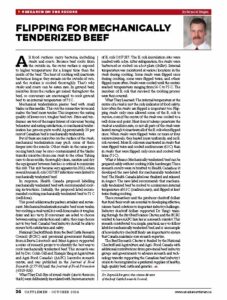Flipping for Mechanically Tenderized Beef
This article written by Dr. Reynold Bergen, BCRC Science Director, originally appeared in the October 2014 issue of Canadian Cattlemen magazine and is reprinted on the BCRC Blog with permission of the publisher.

All food surfaces carry bacteria, including steaks and roasts. Because beef cooks from the outside in, the outer surface is exposed to higher temperatures for a longer time than the inside of the beef. The heat of cooking will inactivate bacteria as long as they remain on the outside of cuts, and the surface is cooked thoroughly. That’s why steaks and roasts can be eaten rare. In ground beef, microbes from the surface get mixed throughout the beef, so consumers are encouraged to cook ground beef to an internal temperature of 71oC.
Mechanical tenderization pierces beef with small blades or fine needles. This cuts the connective tissue and makes the beef more tender. This improves the eating quality of lower cost, tougher beef cuts. Price and tenderness are two of the major drivers of consumer buying behavior and eating satisfaction, so mechanical tenderization has proven quite useful. Approximately 20% of Canadian beef is mechanically tenderized.
But if there are microbes of the surface of the steak, mechanical tenderization may push some of them deeper into the muscle. Other steaks in the same processing batch may be cross-contaminated if the blades transfer microbes from one steak to the other. Taking care to disassemble, thoroughly clean, sanitize and dry the equipment between batches is critical to minimize this risk. This risk became very apparent in 2012, when several human E. coli O157:H7 infections were linked to mechanically tenderized beef.
In response, Health Canada proposed labelling mechanically tenderized beef with recommended cooking instructions. Initially, the proposed label recommended cooking mechanically tenderized beef to 71oC (well-done).
This posed a dilemma for packers, retailers and restaurants. Mechanical tenderization makes beef more tender, but cooking a steak until it is well-done makes it tougher, drier and less tasty. If consumers are asked to choose between eating satisfaction and safety, they may choose not to buy beef. Canada’s beef industry should be able to ensure both satisfaction and safety.
National check-off funds from the Beef Cattle Research Council (BCRC) and provincial government funding from Alberta Livestock and Meat Agency supported a series of research projects to identify the best way to cook mechanically tenderized beef. This research was led by Drs. Colin Gill and Xianqin Yang at Agriculture and Agri-Food Canada’s (AAFC) Lacombe research center, and was published in the Journal of Food Research (2:77-89) and the Journal of Food Protection (6:919-926).
What They Did
Eye of round steaks (1 to 3 cm thick) were deliberately inoculated with known amounts of E. coli O157:H7. The E. coli inoculation sites were marked with a dye. After refrigeration, the steaks were barbequed or cooked on a hot plate (skillet). Internal temperature was monitored at various locations in the steak during cooking. Some steaks were flipped once during cooking, some were flipped twice, and others flipped more often. Steaks were cooked until the centers reached temperatures ranging from 56oC to 75oC. The numbers of E. coli that survived the cooking process were then counted.
What They Learned
The internal temperature at the center of a steak is not the only indicator of food safety; how often the steaks are flipped is important too. Flipping steaks only once allowed some of the E. coli to survive, even if the center of the steak was cooked to a well-done endpoint. Heat doesn’t always penetrate the steak at a uniform rate, so not all parts of the steak were heated enough to inactivate all of E. coli when flipped once. When steaks were flipped twice or more at four minute intervals, they heated more uniformly, and no E. coli survived. More E. coli were inactivated in steaks that were flipped twice and cooked medium-rare (63oC) than in steaks that were flipped only once and cooked well-done (71oC).
What it Means
Mechanically tenderized beef can be prepared safely without cooking it like hamburger. These research results were submitted to Health Canada as they developed the new labels for mechanically tenderized beef. The Health Canada label was finalized and released in August. The new label recommends that mechanically tenderized beef be cooked to a minimum internal temperature of 63oC (medium rare), and flipped at least twice during cooking.
These researchers and the producer check-off dollars that fund their work are essential to developing effective, science-based solutions to important industry challenges. Industry check-off dollars supported Dr. Yang’s training through the first Beef Science Cluster, and the BCRC worked to have AAFC hire her as a research scientist. This research contributed to a simple, practical, easy-to-follow label for mechanically tenderized beef, and is an example of how industry check-off funds are important to ensure that Canada maintains core research expertise.
Click here to subscribe to the BCRC Blog and receive email notifications when new content is posted.
The sharing or reprinting of BCRC Blog articles is typically welcome and encouraged, however this article requires permission of the original publisher.
We welcome your questions, comments and suggestions. Contact us directly or generate public discussion by posting your thoughts below.